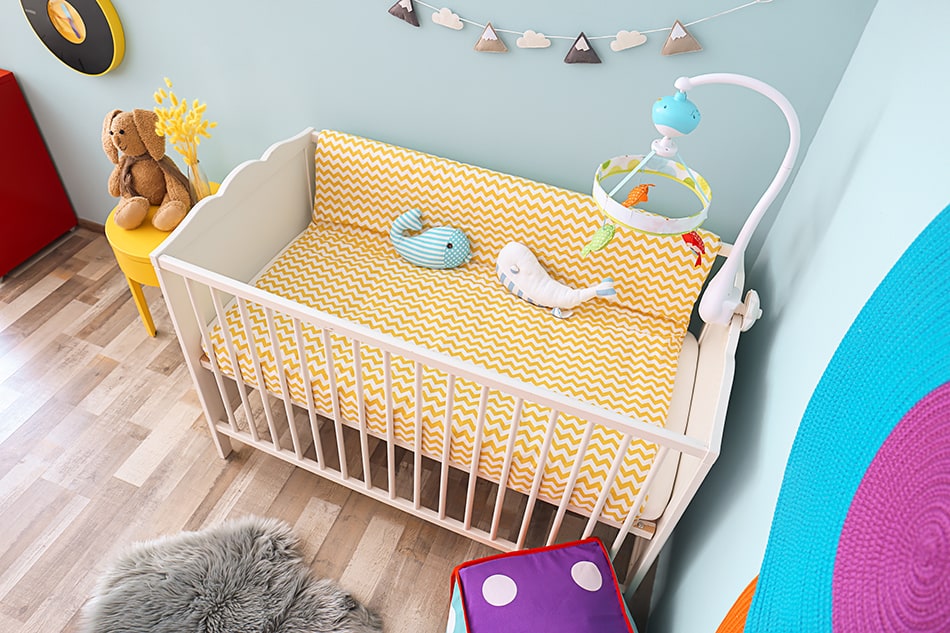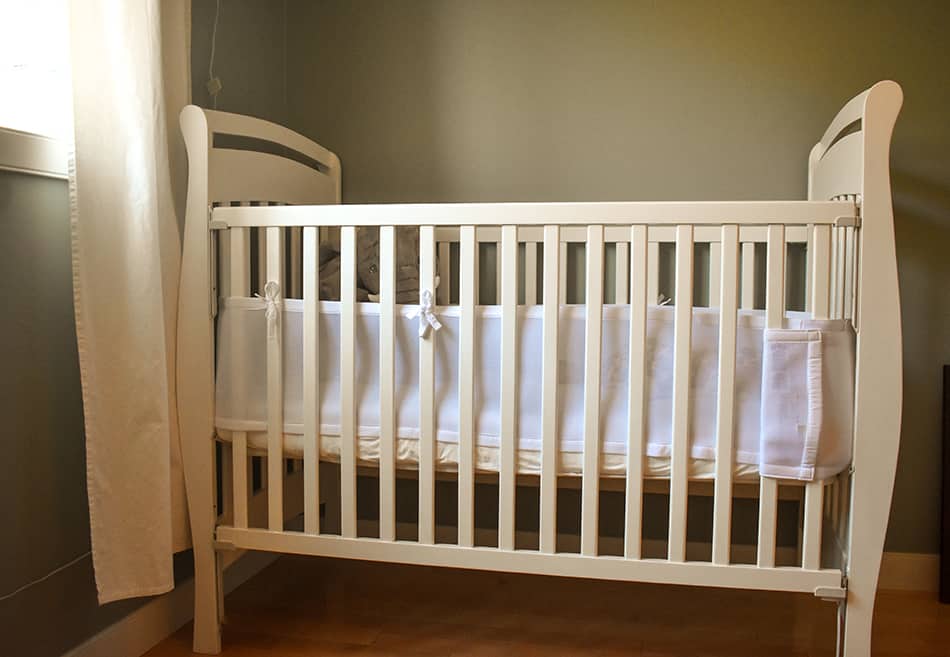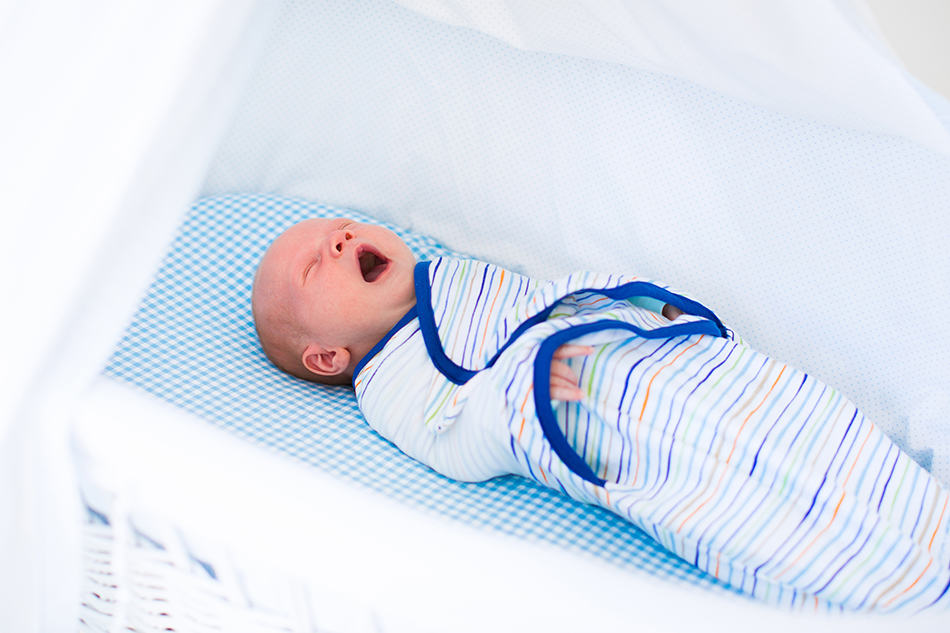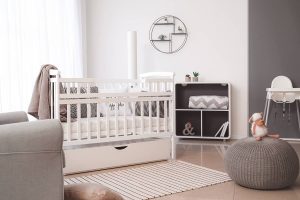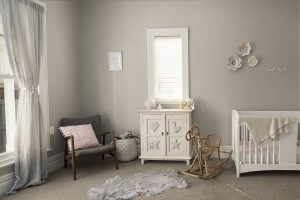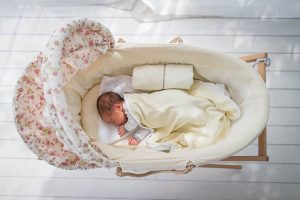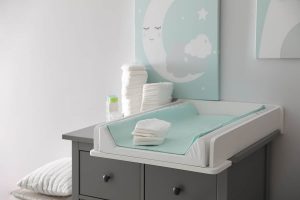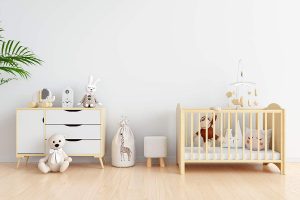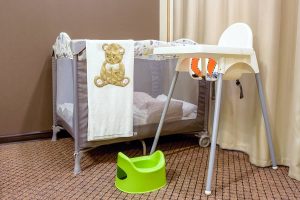If you’re a new parent or you’re expecting a baby, you might be wondering if a crib bumper is something you need to buy in preparation for when your baby sleeps in their crib. Here we discuss the pros and cons of crib bumpers and the alternative options available.
What Are Crib Bumpers For?
Crib bumpers are a much-debated product among parents, as some people feel they are extremely dangerous, while others think they provide a softer space for a baby to sleep.
Crib bumpers are designed to create a soft barrier around the lower edge of the crib to prevent a baby from sticking arms and legs through the gaps in between the crib bars. In doing this, a crib bumper can prevent a baby from getting limbs trapped or twisted and injured when they try to wriggle out of the position.
Crib bumpers are also used as a sort of cushioning around the hard parts of the crib that the baby might come into contact with, for example, to soften the blow if a baby bangs its head against the bars of the crib. Crib bumpers also come in a huge range of styles and colors, so some parents like to use them to help decorate a baby’s nursery and coordinate the items with other nursery soft furnishings such as blankets and diaper bags.
Pros and Cons of Crib Bumpers
Though crib bumpers are designed to limit injury to babies and provide parents with peace of mind, there are many studies that suggest that crib bumpers can be harmful and potentially very dangerous for babies.
Pros:
Creates Barrier Between Baby and Crib Slats
This is one of the main reasons parents choose to have a crib bumper because they feel the crib slats create a potentially dangerous scenario where the baby could get arms or legs trapped between the slats.
Crib bumpers block a baby’s access to the slats to prevent this possibility; however, many experts agree that this benefit of crib bumpers does not outweigh the dangers it poses in terms of suffocation. Crib bumpers can prevent injuries such as bruises or even dislocated limbs, but these injuries sustained in a crib without a bumper are usually mild and cannot cause death, whereas a crib bumper can cause much worse injuries or be fatal.
Soft and Cozy
Many parents feel that the walls of a crib are too hard and solid and would prefer for their baby to be in a soft and plush environment. Crib bumpers create this cozy space and also act as a soft cushioning so that the baby won’t get hurt if it bangs up against the sides of the crib.
Stylish
Crib bumpers can make a crib look really cute, and help to decorate the nursery. They stop a crib from looking cold and bare and can be coordinated with other soft furnishings in the room to create a stylish nursery where parents and babies feel happy and relaxed.
Blocks Drafts
Crib bumpers can block cold air from coming through the gaps in between the crib bars, which can be particularly helpful if the crib is situated near a door or window where cold drafts enter the room. By blocking up these gaps, the crib bumper can help to keep the temperature of the baby at a safe and consistent level.
Cons:
Suffocation Risk
Everyone knows not to use a pillow with a baby because they can get their face pressed up against it, which blocks their airways, and they can suffocate if they aren’t yet strong enough to move themselves away. A crib bumper is effectively just like a pillow but around the edge of the mattress, so this presents a significant risk of suffocation.
Climbing Aid
When a baby is a little older, typically 9 to 12 months, and is able to support themselves up to a standing position, a crib bumper can act as a step up to enable them to climb out of the crib. This is obviously a safety issue as they can hurt themselves if they fall from the top of the crib.
Strangulation Risk
Crib bumpers are usually tied in place with ribbons or long fabric ties, which are secured with a knot or bow. If one of the ties comes loose, it can present a risk of strangulation if it becomes caught around the baby’s neck. It could also become tightly wrapped around a limb and cut off blood circulation.
Increased Risk of SIDS
Sudden Infant Death Syndrome is something that most, if not all, parents worry about when they have a baby. Studies have shown significant links between crib bumpers and an increase in SIDS, and as a result, the American Academy of Pediatrics recommends against using crib bumpers. Hundreds of children have been seriously injured or have died as a result of using a crib bumper since 1985.
Reasons for Choosing a Crib Bumper Alternative
The experts suggest that babies don’t need anything in their crib other than a mattress with a tight-fitting sheet over it, as this is the best way to prevent dangerous situations such as suffocation and strangulation.
For some parents, an empty crib simply seems too harsh, and they want something in the crib to keep the baby from getting to the hard and potentially dangerous bars of the crib. A bare crib can also look a little sad, and parents may want to add soft furnishings to it to make it feel more cozy and relaxing.
In this instance, there are a few crib bumper alternatives that offer the best of both worlds, combining comfort with a higher level of safety compared to crib bumpers to provide parents with ultimate peace of mind.
Crib Bumper Alternatives
Mesh Crib Liner
If your primary concern is that your baby will get their legs or arms trapped in the gaps between the vertical crib slats, then a mesh liner will prevent this.
Mesh crib liners are designed in much the same way as regular crib bumpers, but they are not padded, and they are made of mesh fabric. This difference in material means that the risk of suffocation associated with regular crib bumpers is removed because if a baby finds themselves with their face pushed up against the mesh, they will still be able to breathe through it.
Some parents are disappointed to find that there aren’t as many color and style options available in mesh liners compared to crib bumpers; however, they are significantly safer, and as their popularity grows, the range and choice are also increasing.
The drawback of mesh liners compared with crib bumpers is that they are not padded and therefore don’t protect the baby from banging its head or other body parts against the wooden sides of the crib. It is simply designed to eliminate the chances of limb injury caused by entrapment in the crib bars while being a safer option compared with traditional cot bumpers.
It is not completely free of risk as some mesh crib liners are attached to the crib with ribbons which can be a risk for strangulation. Ideally, look for velcro mesh crib liners to reduce the likelihood of safety issues.
Vertical Crib Liner Pads
This alternative to crib bumpers was designed to solve the problem of babies who get hurt by accidentally banging parts of their bodies against the crib bars. It works by encasing each bar in a protective, padded material that is secured into place with velcro.
These liner pads still leave gaps between each bar where very small limbs could get through and get stuck, but this is unlikely given that the pads greatly reduce the space between each bar to a size that most babies would find impossible to fit through.
The main concern regarding traditional crib bumpers is suffocation, and this risk is dramatically reduced by using vertical crib liner pads because they don’t provide a solid surface that babies can push up against and block their airways. Instead, the gaps between each vertical crib liner allow air to flow through.
Crib Railing Covers
These crib covers are made from lightly padded fabric which is wrapped around the top railings of the crib and secured in place with ties or ribbons.
This type of crib bumper alternative is designed to stop babies from chewing on the wooden railing, which is a common problem when babies or toddlers are teething. These covers will deny babies access to the railings and therefore prevent them from damaging their new teeth or gums, as well as preventing them from causing damage to the crib.
If you were planning on saving your crib for the future when you may add more babies to the family, then you’ll want to ensure it stays in good condition and doesn’t have bite marks all along the top railings. The same can be said if you want to sell your crib after your baby is finished with it. Good quality cribs can be expensive pieces of furniture to buy, so many parents try to recoup some of that cost by selling their crib after they are done with it.
A crib that shows few signs of use will hold its value much better than one with bite marks in the wood, so buying a crib railing cover could save you money in the long run. Crib railing covers can also prevent youngsters from getting limbs caught in the upper parts of the railings, which might happen when they’re big enough to sit up and reach their arms through the higher parts of the crib.
Crib railing covers create a barrier around these parts of the railings to minimize the chance of injuries of this nature from happening.
Crib railing covers are typically padded, and so they present a soft surface on the railings in the instance that a baby bangs their head on that part of the crib, though some versions are not padded, so be sure to look out for this feature if this is a specific worry you have about your child. They come in many colors, patterns, and styles, and so can be used to help decorate a nursery for baby boys or girls and make it look cozier.
Unlike traditional crib bumpers, crib railing covers do not create a barrier close to the mattress where the baby sleeps, and therefore they don’t present a suffocation risk. The drawbacks of crib railing covers are that they may present a risk of strangulation due to the ties that these products use to secure themselves to the crib.
Swaddle Blanket
If you are concerned about your baby getting their limbs trapped in the railings or bars of the crib, then swaddling them could be a good option. There are different baby blankets sizes and shapes, so make sure to choose the one that you can swaddle the baby.
This method of wrapping your baby confines most of their body, excluding their neck and head, to the inside of a cozy blanket, therefore giving the parents complete peace of mind that they won’t get caught in the bars without the possible safety dangers associated with using a crib bumper.
Many parents are fans of swaddling as it helps a baby to feel safe and secure, tightly bundled up in a similar way to how they would have felt in the womb. A content baby will typically sleep better, and so some parents use swaddling as a tool to get a better night’s sleep, with the added bonus of knowing their baby is cozy and safe. The drawback of using a swaddling blanket is that overheating can be a problem if the blanket is too thick, so be sure to always use thin material.
You can also inhibit correct hip growth and cause hip dysplasia if you swaddle the legs too tightly or straighten them out in the swaddle, so always allow the baby to position their legs at a natural, slightly bent angle similar to a frog’s legs, and be sure to wrap them comfortably, so the blanket is secure but not tight.
